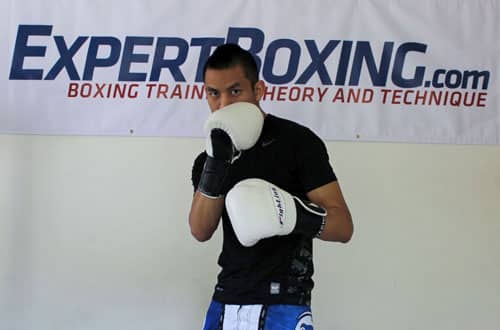
We’ve all been under pressure before. We take the most punches when we’re out of energy, out of room to move, and out of position to fight back. I can barely stand let alone defend myself!
That’s the problem with most defensive techniques–they rely on some kind of “perfect position” that just isn’t possible when you’re getting beat up!
Well that’s all going to change today (in my sarcastic professional salesman voice). I’ll show you a trick the pros use to defend against combinations, WITHOUT THINKING, simply by moving your back hand.
This little defensive technique can protect you even when you’re unable to fight back…
What’s the back hand guard?
*** Disclaimer: I have no idea what this defensive technique is really called. I’m pretty sure the old-timers have a name for it but I don’t know what it is.
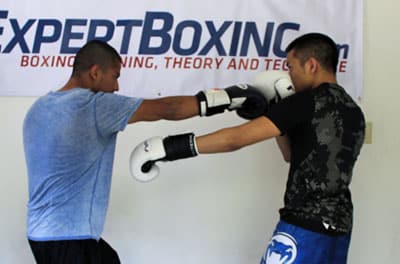
The “back hand guard”, as I call it, is a defensive technique of using your back hand to block both sides of your face. The technique is useful (if not crucial) when you only have one arm available and need to block punches from both your left and right side.
Although you won’t see it too often in the amateurs, the pros will use this move often at close range to block right crosses and left hooks while using their front arm to fire back counters. Watch any inside fighter and you will see the back hand guard in use quite often.
The idea is simple in theory: move your back hand to the left side of your cheek to block right hands, and then return it to the right side of your cheek to block left hooks. In reality, the technique can get you into a lot of trouble when used incorrectly. It can develop lazy punching habits and an over-reliance on blocking (and covering the eyes) as defense. You don’t see many trainers teaching this move to beginners because it easily develops bad habits.
How to Use the Back Hand Guard

- the first position blocks right crosses to the face
- the second position blocks left hooks to the face
- immediately bring your glove to the other side after blocking
The back hand guard technique is simple. You simply repeat the 2 positions above over and over. I use this guard technique only when absolutely needed, which is when I’m stuck against the corner. I’ll cover my body with my front arm and then use my back hand along with shoulder rolls to deflect all the head punches. It’s a fun move to do and defends well without having to rely on such fast reflexes!
The back hand guard is a great defense,
when you don’t have the reflexes or ability to fight back.
For good examples of this technique, I would recommend for you to watch pro fighters. The long-range boxers will use the back hand guard to block long right hands. They simply put their back glove in front of their face to deflect the right hands. The close-range inside fighters will use the back hand guard more actively to block both rights and lefts from close range. Watch a pro fighter and see what he does when he’s stuck against the ropes. All pros are generally pretty good at this move.
Some examples of good back hand guard movement:
- Miguel Cotto vs Antonio Margarito – look at what Cotto does along the ropes, he’ll use his back glove to block both lefts and rights from time to time
- Joe Frazier – watch how Frazier wades into distance by using the back hand guard
- Julio Cesar Chavez – watch how he slaps right hands away with his right glove when walking forward
Let’s See the Back Hand Guard in Action
Watch my video demonstration of the back hand defense!
Long-range Defense
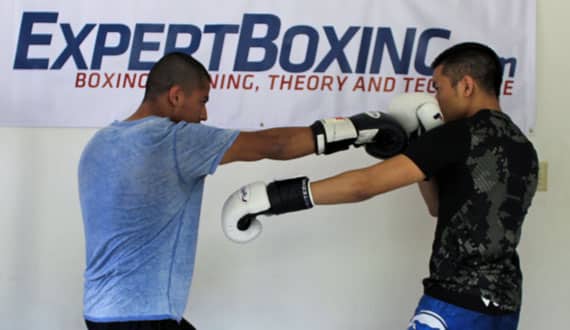
This right here is the essence of the back hand guard technique! Move your back glove to the front of your face to block right hands when your left arm is not in position to do it. This position is useful when your opponent throws counters while you’re busy jabbing. Or maybe you’re busy doing other things with your left hand and your opponent comes in with a right. Whatever the case may be, cover the hole with your right glove.
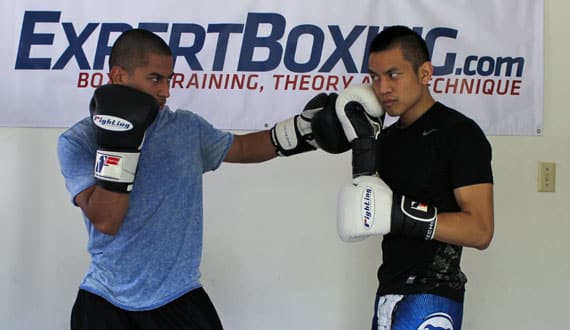
And then move the glove back to your neutral position to block the follow-up left hook! By the way, there’s no rule saying you have to block the follow-up left hook. If you know a counter for it, go straight into your counter!
Close-range Defense
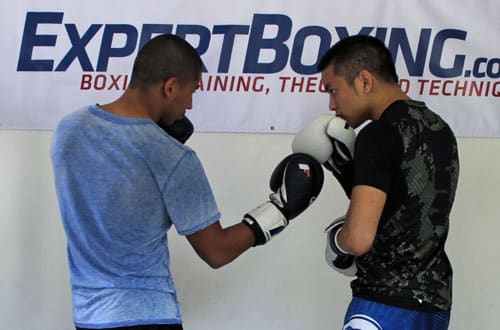
The back hand guard is especially useful at close range! You’re bound to get into situations where you have no idea what’s coming. Your opponent’s throwing left-right-left-right and hitting you everywhere. All you gotta do is stop a right hand by putting the glove in front of you.
*** Notice how I used the back hand guard to stop an uppercut at close range. ***
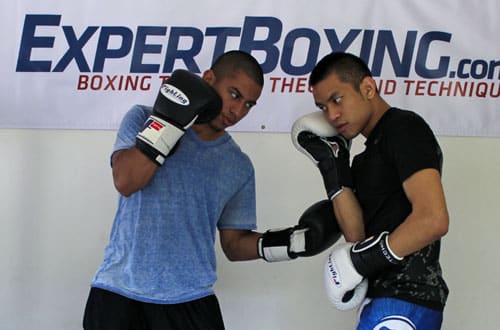
Now immediately move the glove back to neutral position to block the follow-up hook. It’s all easy from this point, keep moving the glove back and forth across both sides of your face to cut down all his punching opportunities. Once you regain your senses, fire back immediately or get the hell out of there!
The slickest fighters have this defensive technique down perfect. You can trap them and they’re still incredibly hard to hit even with only one hand. Many of them will use that free hand to throw a deadly counter hook.
Tips for the Back Hand Guard
Move your hand immediately after blocking
Move your back hand to the other side immediately after blocking. Fast punches will typically come in left-right-left-right patterns. This is especially true when you’re being bombarded. I’m sure a lot of people are going to argue with me and say, “But what if he throws two rights or two lefts in a row?” I have an answer to this…
The back hand guard is often used as an automatic defense. By automatic I mean that it’s what you should be doing automatically when you’re not prepared to actively defend. Sure you might get tricked by some double rights or double lefts but statistically it’s safer to be moving around and doing something than to sit around and look for actual punches. Once you’ve got your defensive pattern figured out, you can then look for more opportunities. If you’re unable to see or unable to think, moving the back hand automatically will help.
Use shoulder roll deflection technique
The trick to the back hand guard,
is to move the head to the opposite side of the hand,
not vice versa.
The trick to using the back hand guard is not to rely only on the hand movement. If anything, you want to rely on simultaneous body movement to roll off the punches. Instead of only moving your hand from side to side, see if you can move your head (and body) to the other side of the hand. Imagine the hand is a wall and your head is moving around the hand (using shoulder roll technique), instead of moving your hand around your head.
Use shoulder roll counters
When you get comfortable with this back hand defense technique, fire back! The easiest counters to throw are the ones you would do using the shoulder roll technique. If you rolled away from a right, come back with your own right. Or if you rolled away from a left, come back with your own left. Or if you have long enough arms, try reaching forward with your free left hand and throw a jab or push your opponent away.
Throw jabs with the back hand guard
I’m sure you’ve seen this before. Many fighters will step in with long jabs while placing their back hand in front of their face in anticipation of right cross counters. It’s not a bad idea but make sure you watch out for counter hooks. I usually catch on to my opponents by jumping in with lead left hooks because I figure he wasn’t planning to punch with that right hand anyway.
Fighting from the back hand guard position (OPTIONAL)
Some fighters (NOT ME) will stand with their right hand positioned by default in front of their chin. And then they move the back hand to the side only after they block a right hand. Doing this can help you avoid quick right hands but it might leave vulnerable to tricky left hands–which is why I don’t do it. But at least you know the option is there. (It can be a useful technique if you’re a taller/longer fighter and your shorter opponent can’t reach you with left hooks.)
Potential risks of the back hand guard
One-armed Fighting
This is probably the number one risk of getting good at the back hand guard. You start fighting like a swordsman–using your front hand to throw long jabs and the back hand to block like a shield. One arm only attacks while the other one only defends. If you don’t fire with your powerful back hand, it’s only a matter of time before your opponent walks in with power punches from both his hands.
Lazy jab recovery
Another big problem of relying on a back hand guard is that you start throwing lazy jabs. You’re no longer worried about recovering the jab arm quickly because your back hand is ready to catch the counter-cross. Personally, I would say this is a bad style unless you’re a really long armed puncher. Smart opponents will find new ways to capitalize on your slow recovery and you won’t have the recovery muscles to out punch them.






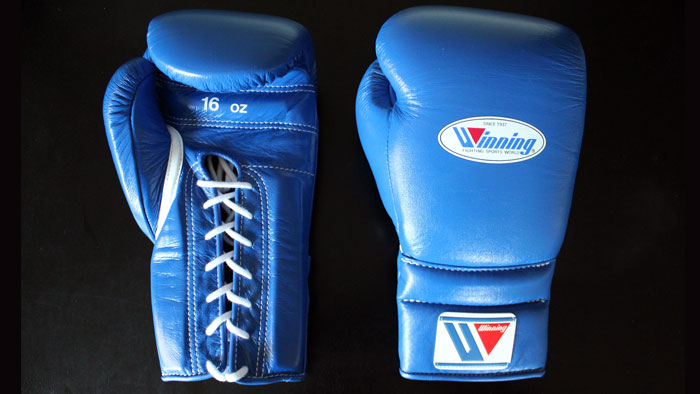

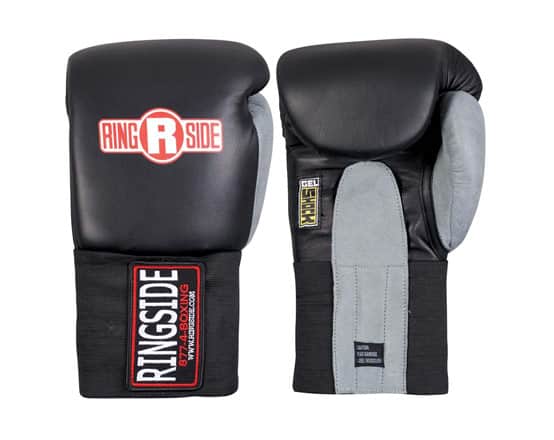

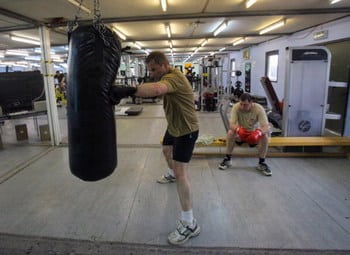
hey there EB, I am extremely interested in learning some of these slick defensive tricks but Im a southpaw. Im not quite sure how to apply the techniques being southpaw unless I was fighting another southpaw maybe…In fact, I cant find any resources on here, or online for that matter that instructs the lefty on how to resort to a philly shell or shoulder roll style defense so im not even sure that its worth the time and trouble it would take to learn it. Any advice would be much appreciated!
Hey nrizzle. I’m not a southpaw so I’m not 100% confident about teaching what I don’t really know for sure. Maybe I can ask one of my friends to do a guest post on the intricacies of fighting as a southpaw.
thanks, it would be much appreciated. Im a very flashy fighter… (tassles and the whole nine) so this mayweather-esque style has always appealed to me. I know that flash and show shouldnt take precedence over form and technique, but I also think that it affords you confidence and dominance(over your opponent) mentally bc you simply appear so confident. (hence roy jones jr, and hector camacho). These guys to me were great, but they were also very intimidating which certainly didnt hurt their ascent to the top of the heap in their respective days.
Back to my point, please, please plead and beg with a smooth and savvy defensive minded southpaw to throw me a bone and get my game on track. Thanks!
p.s. – My first fight is in 14 days, and your website has been invaluable to my preparation. It has even given my trainer new ways to train and shock my body from our normal routine. Thanks I feel simply isnt enough…but thanks none the less. haha
Great vid johnny
Are those 18oz gloves? They look huge!
They’re 16oz but they’re sparring gloves which are usually more puffier so you don’t hurt your sparring partner as badly. Then again, I also have small skinny wrists that make the gloves look even bigger. You’re welcome!
Sorry I forgot to add – great video! Thanx!
What about when someone doubles up the left hook on you.?? Or maybe a a quick throw away right hand and then a hard right hand. As soon as you feel the right hand or left hook and you switch to the other side of you defense would you get caught ?
Please read the guide, this move is vulnerable to double lefts and double rights. Nonetheless it is still more effective than not doing anything. Use with caution!
Hi guys! recently i started the boxing and i want to know how to increase my boxing skills and stamina.please contact me at [email protected]………….
This back hand guard technique is one of those that fall under ‘active defense’ , along with shoulder rolling. They seem to pair together well. I’ve been practicing this, and the weight transfer/core twist seems to be very similar. Can you elaborate more on this? Especially when stepping forward, backward, diagonally? When I shoulder roll the right hand, am i aiming to use my left shoulder in order to ‘cut across’ the centerline of my opponent, or me? or is just just the path of the right hand? It has worked when I’ve been trying it out in sparring, but i feel there’s either a distance issue or angle (of my opponent) when he throws that right hand that can still hit me, especially when im not exactly sure where the ‘ideal’ angles are. To clarify, i mean right hands aimed for the top of the head instead (straights or hooks) and overhands. Using this method of defense, how are we dealing with these attacks?
Jae, you’ve got some great questions. The intention of this article was to open your eyes to another defensive method. The technique is effective in some situations and nowhere near as effective in others. It’s good for high hooks but not so good at high right hands. This is why it’s better to rely on a roll deflection than simply placing the glove up high. (You can see James Toney rolling off many high right hands.) Ultimately, you will must skip this technique when it doesn’t work and do something else.
isnt this style used by floyd mayweather?
It’s not a style, it’s a technique. And the technique is used by many fighters–some more notably than others.
Fighting or sparring against someone who is good at this can be the most frustrating thing. You anticipate traded blows only to find that his is the only one that ever lands.
Frustrating, indeed!
so you cannot use it when you are short armed?
Not true at all. Everyone can use this technique but a short-armed fighter might use it differently than a long-armed fighter.
everyone in my gym uses this technique, short and tall. I’m 5’5 170 and i use it on guy who are 5’10+. The only difference when using it as a short guy is that you need to step in and get your weight and muscle behind the rear hand. Also, I find it much more effective to use the rear hand to block the jab, and counter with your own jab simultaneously. If you are a lot shorter, you will dodge hooks by simply stepping in close to the. I actually find it harder to fight people my size as opposed to fighting taller people using this technique.
just what i hav been working/experimenting on this week xD ty alot, it saved quite some time and brain dmg xD keep up with all the articles u make, they r brilliant
can you use this technique by avoiding the left hooks with angling your body? i cant find the video to support this :\ but i do have another one i believe you seen this video before but floyd mayweather loves to use this technique
https://www.youtube.com/watch?v=uR8XQDbZo4Q
it should start at 3:15
This technique, although similar to many others, is intended to block head shots with your back glove. Anything else that is not the same, is a different technique. Use what works.
I’ve used my right that way on the street for some time.
Reason being that the left hand can’t always be up (“high guard”) because it may have to block kicks and so forth.
One time I actually caught a “sucker” right hand that a guy threw at me in the palm of MY right hand.
However, I would NEVER depend on the right ONLY for defense, but would always be prepared to launch an immediate counter attack.
Anyway, I’ve also seen Ken Norton batting punches away with his right as he comes in with his left hand down in a position to throw the left hook.
I like it!
Thanks for another great article Johnny!
Watch how Ken Norton uses his right hand to block AND punch!
One of the best fights EVER!
Larry Holmes vs Ken Norton
https://www.youtube.com/watch?v=hHSTSh-ypcw&feature=related
i think the name for that technique is : philly shell
The philly shell is a position. This is a defensive technique that can be used in many positions, not only the philly shell.
Hi coach, been reading this wonderful site for years now – it’s already motivated me to start training and has helped hugely with my progress – whenever I want to know how to improve, I’ll find insights and inspiration here!
I was wondering, could you do an article on the Philly shell itself? I love using it, though the trainers at my gym prefer me to use the textbook guard as my default at present.
a clear example of this guard is Evander Holyfield vs. George Foreman, both use this technique
Would i be wrong to think of this as a type of perry or not?
by the way just a quick question: If i was a pro boxer and i wanted to go to the body what would be the most practical way to create a solid and sustainable series of openings or just a opening i could keep on repeditivly using without being just that little bit too much predictable?
keep up the good work i think this is the best artical in ages!
Errr…I would say it’s more like a block with a shoulder roll body movement. It’s not a parry.
About your body punching question, there is no easy answer. My best tip is to go for the head if you want to open up the body.
Evander Holyfield also used this technique. It was especially important during the first Tyson fight. But you can find many examples of Evander employing this method for defense.
Also, I liked how Holyfield would slip a jab to the inside — I try not to ever slip to the inside — and then crash in on his opponent, use his right hand to pin down this opponents right hand, then unleash a double hook, body then head or whatever was available. When he had his reflexes, that always got me excited.
In my gym the fighters shoot the jab with the back hand already in position in front, like when you lower yourself targeting the stomach. Old timers used to adopt this guard, I also see an almost-80 ex-pro who defends himself with the back hand in front of the face and the arms parallel to each other, sinking the head in them. I saw De La Hoya using this same defense.
I’ve always called this the Sword and Board technique for when you are sore and burnt =p
Ahhh, yeah… I call it the “sword and shield” technique sometimes. It’s definitely common the more beat up you get.
very nice! i use this tehnic to parry jabs mostly
here goes a different way of what your saying johnny
https://www.youtube.com/watch?v=ImO5WQQgA70&feature=g-vrec
I know this off subject but do you agree with this jab?(having your palm horizontal during your stance?)
https://www.youtube.com/watch?v=eiFnITDSn4w&feature=relmfu
I agree with him completely. The technique works because you don’t have to rotate the jab and it’s more likely to land in the optimum position especially for guys with a slow rotation (weak shoulder muscles or poor technique). The only drawback is that if you tell beginners to hold their front arm like that, they’ll usually screw it up by lifting the elbow up at the sides and exposing their mid-section. This position can also leave you vulnerable to overhand shots if you don’t have good head movement. Overall, it’s logical technique and has it’s purpose and style when used correctly.
hello everybody,
i am ankit. i have recently started boxing. i want to know how to improve my stamina in da ring and how do i improve my punching techniques.
please contact my at [email protected]
sorry, its [email protected]
wont you be vulnerable to a tap to the head and body shot left hook?
Well that combo is effective if you fall it. You’ll get hit if your defensive awareness isn’t where it needs to be. Every defensive stance has its weaknesses. The best thing is to rely on your awareness instead of only the hand position.
hi, could you talk about different styles of mittwork? what you think about the style of Floyd? you do it?
what about this guy?
Coach.Rick.vol.1.basic.technical.mittwork
http://filecloud.io/uh9pkz2m
Coach.Rick.vol.2.basic.advanced.technical.mittwork
http://filecloud.io/maikvhbx
Coach.Rick.vol.3.advanced.technical.mittwork
http://filecloud.io/qdya59eb
hey there guys, just wanted you to know that after I asked you about southpaws, and how effective they can be, I have been trying to find ways to work this dfense into my bag of tricks. I have been catching the jab with my rear hand, and turning to the outside (my left) in a shoulder roll fashion to intercept the right, and either choosing to use my shoulder to parry across their body to open up for a left uppercut/vertical handed straight to the liver- OR to let the straight right slip across the top of my right shoulder to either come up with a right uppercut or simply jab to the solar plex,drag straight up from there to catch him under the chin and set up the straight left. VERY EFFECTIVE, especially since the guys in the gym I always spar with have never seen it coming from me before. Try it out if you like… if anyone else has anything to add Im all ears. Thx expert boxing!!
/\ btw, I meant effective at this type of defense… /\
hey ive always worried about attacking first because of fear of getting countered should i suck it up and attack first or try and counter by letting him throw first
Sometimes, you gotta attack first. Other times, you have to wait and counter. The important thing is to be trained so that you’re not afraid to do either. I have to say, it’s scary to attack when you know what’s coming back! So train harder and get the hell out of the way. Or hit him so hard that he doesn’t fight back.
Hi Johnny,
My name is John and i am from the Netherlands. When i was 15 i started with boxing until i was eighteen. Now, almost 13 years later ( i now am 31 years young) i’m stared boxing again. About a your i like to have my first boxing match.
Yesterday i visit a amateur boxing competition. I am about 180 pound (a heavyweigt) and a tall guy. Yesterday there was a match between two boxers, it was their first match. One guy was tall and skinny and the other was short big arms.
Most of the time the short guy was giving a lot of hooks, to the head and to the body. But most of it was a high right hook to the opponents head. The tall guy was hitting most of the time by this punches.
My question is…what is the best way (for the tall guy) to block or defense these hooks, and above all, how to block and defense these high right hooks???
I would be glad if you can tell this to me, so i can practise on this a lot. So that i will be prepared
on this myself.
Greetings,
John
There are several ways to avoid high hooks. You can block them, or roll away, or use footwork or use your jab so that your shorter opponent can’t even get into range to throw them.
With all due respect, I analyzed your boxing training videos and after viewing and analyzing them “YOU DO NOT KNOW THE TRUE ART OF BOXING”, all of your boxing training techniques are flawed and incorrect! What qualifies you to even consider teaching boxing! I strongly suggest that you remove these flawed training techniques from youtube.
Thank you for your suggestion, Alex. I will erase this entire website and delete my Youtube videos immediately!
Ha! What a jack-ass….I’ve been boxing for years and you are just put into words (very well) what most coaches don’t put into words.
question:
i have a training partner who is an orthodox fighter (i am south paw) and his fave combo is jab, and then he would dive into an overhead right hand. i was wondering if the glove in front of my face would be enough to minimize damage? … i usually just move out of the way everytime he does that, since i dont want to risk getting dazed with a charging overhead punch. what else can i do to minimize the impact so i can set-up counters?
It’s a common tactic and one you’ll have to learn how to deal with. Putting your glove in front of your face is better than nothing but it won’t do too much if he’s clever about throw those overhands. Your best option is to move or counter. Overhand rights are usually pretty obvious so you should be looking out for the tell signs that he’s going to throw it. You can also find ways to position yourself around him that make it harder for him to throw it.
thanks johnny!
i learned to deal with his overhand by catching him with an uppercut when he dives down and charges.
i’m learning how to use the “back hand” guard and i noticed it works on some guys more than the others. the one it worked on was a jab heavy fighter. when i put the glove in front of me, his jabs stop. i guess it intimidated him or something lol
It really works great. Sparred today using the backhand technique and countered his Jab with my own.
Hey Johnny,
Dude, this Alex Lampert kid is so stupid. Delete your youtube immediately? Seriously? Lol, he is an absolute retard. I’m glad you came back with a sarcastic remark. Your instruction is fine. Keep doing what you’re doing.
Best regards,
Ali R.
Isnt that stance regarded as the “Detroit style” ?
A lot of people use this technique. It’s more of a movement than a stance because you can use this tactic from any stance.
johny, i owe you an apology. i once told you i didnt believe slipping and parrying together are a good idea or something fighters should learn until theyre pretty advanced.
but i was studying footage of southpaw-southpaw and noticed how effectively fighters benton trained do it (whitaker ramirez II).
ive been showing it to younger boxers and i was just amazed how well they do with the slip setting opponents offbalance. its a timing thing. they do it better than me maybe because they learnt it so early. its amazingly useful for them in sparring. i am now sparring to allow opponents to hit me while i try and use specific defenses i am not so good at slow, then ill drill this in with my normal techniques. ive been developing slipping outside the right hand (or the southpaw’s left when i stand switched) and using the backhand to parry the hand a little is much better. and i was wrong, when done right there isn’t any risk of steering the punch into myself. when i was quicker it was nicer to just slip and keep the hand free or just parry and shoot over. using the backhand defense allows one to parry, to slip with a little protection.
but it has its problems and therefore it shouldnt be the primary defense. its easy to get feinted into the movement too early, and the lead hook to the temple and body is dangerous in such situations. i got the better of this defense by throwing power shots with a little loop in them which are slower and therefore the parry comes too early and theyve slipped themselves into range for a chopping overhand right. it also leads them into a left uppercut/hook. throwing a fast no-power tap onto the glove makes them slip and their parry hand will miss the short punch leaving them open to the left hook which they move into (or the shovel hook depending on how low they go) or the short right hand which is parked right at their glove after the tap.
when combined with normal slipping, parrying and blocking it becomes a dangerous move that allows one to turn to offense quickly. so both opponent are changing up offensive counters to defensive moves and vice versa.
wonderful stuff johny, more old school stuff please
More old school stuff is on the way!
I use back hand guard technique 100% percent as my inside guard and outside. Recently during a sparring drill of (only blocking) any variety of inside combinations at fast speed consisting of feints as well, I noticed I was taking a hits. I realize I can not block all of them. (Granted what hit was not that strong, is this a realistic way to train?-considering during sparring I do decent and hardly take any solid hits because of offense counters.) Should I be able to block all inside combos/feints with this back hand guard technique during only blocking drills? This drill made me realize how important being offensively active is. Offense is blocking. I been involved in martial arts for 3 years and boxing 1 year. Thank you.
It’s never enough to rely only one defensive technique. You need to be comfortable with a wide variety of defensive techniques to keep you safe throughout the various situations in boxing. Practice using focus mitts and live-sparring would be the best way to practice. Take your time. 1 year is still very much a beginner.
My first coach was super old scool and he called it a “check” or “check-hand.” He always said for me to drop my head back a little, check the hand and roll to the outside and deliver either a hook or a quick over-hand right (looping is what they call it today I think).
Hi Johnny,
I know this may sound a stupid question but when you are blocking the left hook is your Palm open so you are blocking the punch with the back of your hand or are you blocking it with a loosely clenched fist?
Thanks
Mike
I’m usually blocking it with more of an open-hand, but sometimes it IS a loosely-clenched fist. My hand is relaxed and I don’t think about it much.
That’s great. Thanks.
Hey Johnny I was wondering about your thoughts on using this as last ditch defense against slightly wide right hooks usually I can read it and and sometimes even bait so I either move away or beat the to the punch but one of my sparring partners is quite sneaky with and can catch me from time to time also is it possible to use this technique to defend the temple area or is that part of the reason for roll thank you in advance
Yes, you can use it as a last ditch defense against wide hooks. I do it from time to time.
Thank you for the replay
I think they call it a baseball catch when you are catching the cross.
Johnny N,
I was taught how to use this guard from an old school trainer. You can block almost any punch thrown at you holding your right hand in this position. It’s also a great position to catch and shoot punches. I can understand how some will start “sword fighting” but with good footwork, accurate punching and good eyes this is technique amazing defensive and offensively.
Any tips on using this technique against a Southpaw? My trainer had me working on my defense using this technique, shoulder rolling, and head movement. I found it a little more difficult using it against a Southpaw.